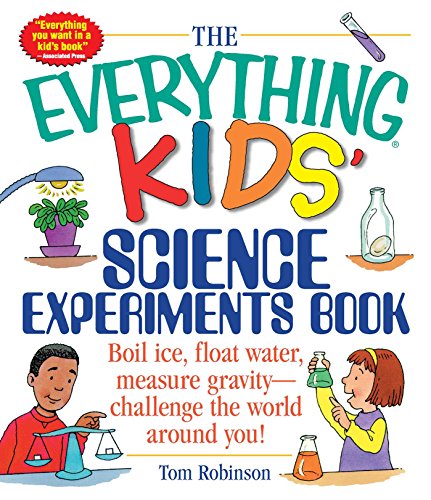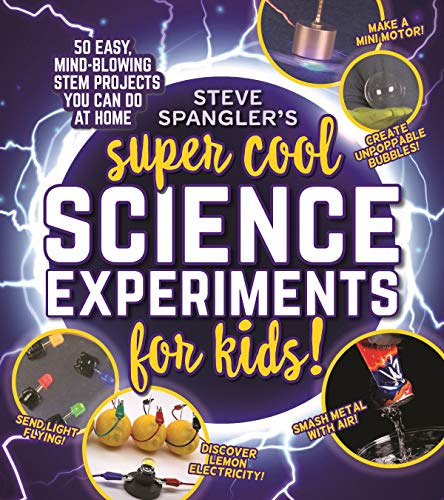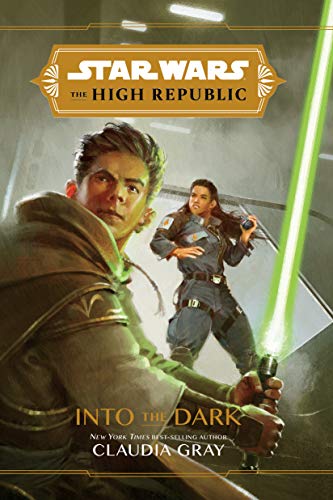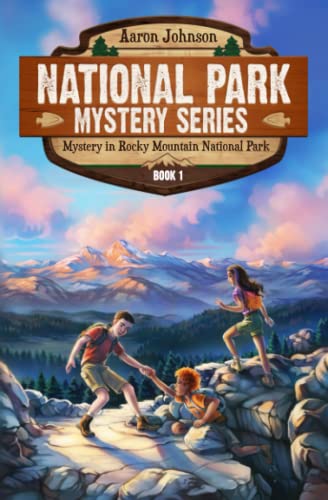If you're looking for ways to spark creativity and curiosity in your 8th grade student, nothing beats a good science fair project. They're a great way to inspire learning and promote critical thinking, while also strengthening communication and presentation skills. However, with so many ideas and options to choose from, it can be overwhelming to get started.
Before diving into any project, consider your child's interests and strengths. Look for ideas that align with their passions, while also challenging them to learn something new. Additionally, take into account factors such as cost, feasibility, and availability of materials. It's important to choose a project that can be completed within a manageable timeline and with accessible resources.
Some great questions to ask include: What areas of science interest my child the most? What materials and equipment are readily available? How much time and effort can they realistically dedicate to this project? By considering these factors, you can help your child choose the perfect science fair project that both challenges and inspires them. So what are you waiting for? Get ready to unleash your child's inner scientist and create a memorable and rewarding experience!
10 Best Science Fair Projects For 8Th Grade
| # | Product Image | Product Name | Product Notes | Check Price |
|---|---|---|---|---|
|
1
|
The product is ideal for teaching children and teenagers about climate change, global warming, and science through educational STEM toys.
|
|
||
|
2
|
The product is ideal for young children interested in science, featuring over 15 experiments and activities such as crystal growing and volcano eruptions.
|
|
||
|
3
|
The product is ideal for children aged 8-14 who are interested in STEM subjects, specifically chemistry experiments.
|
|
||
|
4
|
The product is ideal for children aged 8+ who are interested in learning about weather and scientific meteorology through STEM projects.
|
|
||
|
5
|
This educational activity book is ideal for children in grades 5-8 who want to learn about physical, life, and Earth science.
|
|
||
|
6
|
The product is ideal for kids and teens interested in robotics, coding challenges, and engineering projects related to space exploration.
|
|
||
|
7
|
The product is ideal for young children who want to explore and experiment with science in a fun and interactive way.
|
|
||
|
8
|
Ideal for parents or educators looking to engage children in hands-on STEM activities at home or in the classroom.
|
|
||
|
9
|
The product is ideal for Star Wars fans who enjoy reading epic adventures in new timelines.
|
|
||
|
10
|
The product is ideal for fans of mystery novels set in national parks.
|
|
1. Stem Toy: Clean Water Science Lab Kit.
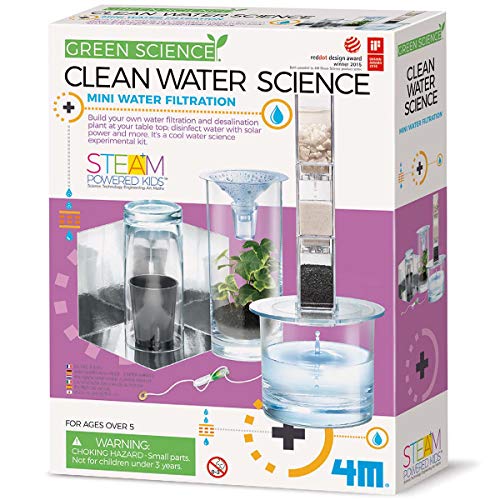
Introduce your child to the science of water purification with the Personal Desalination Kit. This kit is a great way to teach young science enthusiasts about chemistry and the environment. The kit includes a plastic filter system, active carbon, sand, rock, and filter paper. With detailed instructions for use and care, this kit is recommended for children ages 8 years and up.
The Personal Desalination Kit is just one of many educational toys and kits offered by 4M. Their products cover a wide range of educational subjects, including science, arts and crafts, and robotics. With 4M, your child can build a clock, crochet a placemat, or turn their room into a planetarium–all while having fun and learning.
This kit is perfect for conducting interesting water purification experiments. Your child will learn the science of cleaning and reusing dirty water. Just add a glass of water and create a "Green Science" project that will challenge your child's imagination.
- Teaches the science of water purification
- Includes detailed instructions for use and care
- Offers a fun and educational activity for young science enthusiasts
- Part of 4M's wide range of educational toys and kits
2. Nat Geo Earth Science Kit: 15+ Experiments!
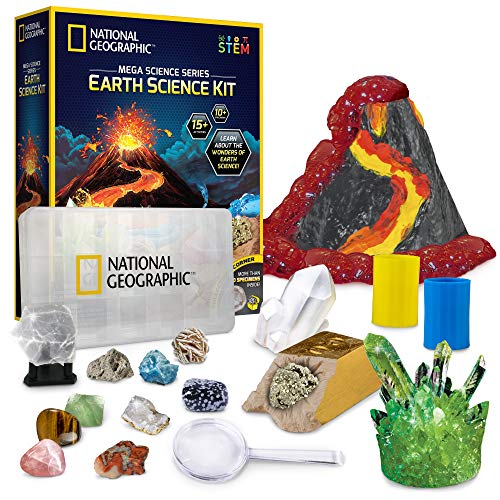
The National Geographic STEM series presents an incredible science kit for curious kids that features more than 15 experiment activities. This kit allows children to conduct multiple experiments and is perfect for sharing with family, friends, or classmates. The kit includes a detailed learning guide that teaches the science behind each experiment, helping your child develop a deep, lasting appreciation for a variety of Earth sciences. The experiments are hassle-free with clear, easy-to-follow instructions that build young scientists' confidence as they explore the magic of discovery. The kit includes dueling water tornadoes, building an erupting volcano, growing a crystal, two geologic dig kits, and much more. The National Geographic STEM series provides high-quality educational toys that are a whole lot of fun, and they guarantee satisfaction. If you're not satisfied with your experience, they'll make it right for you.
- Includes over 15 different experiment activities
- Allows for multiple experiments to be conducted
- Detailed learning guide teaches the science behind each experiment
- Experiments are hassle-free with clear, easy-to-follow instructions
- Great to share with family, friends, or classmates
- Helps develop a deep, lasting appreciation for a variety of Earth sciences
- Provides high-quality educational toys that are a whole lot of fun
- Satisfaction guaranteed
3. Einstein's Stem Chemistry Kit: Young Scientist Edition
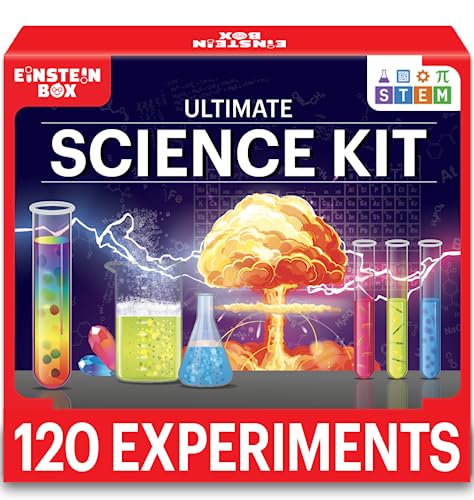
Introduce your kids to the fascinating world of science with this all-inclusive science kit that offers 100 experiments to perform! With easy-to-follow instructions and video guides, your kids will have hours of fun exploring the kit and learning like a real scientist in a lab. The kit comes with a detailed manual that teaches your child to complete the science experiments step-by-step. Each experiment is fun and easy to conduct, and the simple, illustrated instructions make it easy to start creating and learning.
To ensure safe and hassle-free experimentation, the chemical materials are put in separate leak-proof bottles. This feature makes it easy for kids to perform the experiments multiple times without creating any mess. This kit meets all the U.S safety standards of ASTM F963-17, making it completely safe for kids aged 8 and above. It is the perfect gift for kids who love science and want to learn more about it.
- Includes 100 experiments to perform
- Easy-to-follow instructions and video guides
- Detailed manual to teach kids step-by-step
- Chemical materials in separate leak-proof bottles
- Meets all U.S safety standards of ASTM F963-17
- Suitable for kids aged 8 and above
4. Science Lab For Children – Be Meteorologically Stunning
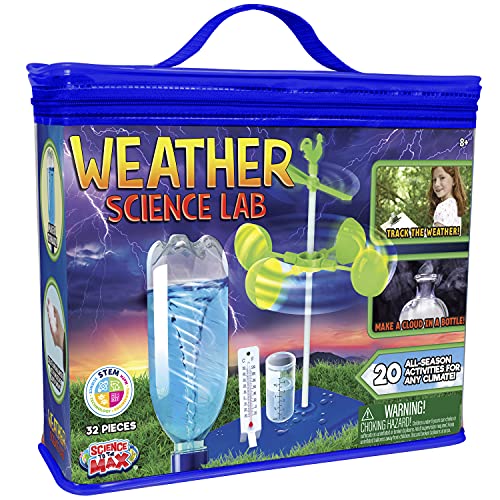
Introduce your kids to the fascinating world of weather science with this Scientific Weather Science Lab Kit. Designed to educate the budding meteorologist, it comes with 20 all-season activities that cover a wide range of weather-related subjects. Whether you want to measure temperature with a real-life thermometer or atmospheric pressure with a barometer, this kit has it all. It even includes instructions on how to create a cloud in a bottle and identify different types of clouds. With this kit, your young scientist can chart and predict the weather like a pro!
The Weather Science Lab Kit is perfect for sparking your child's curiosity and imagination. It not only teaches them about the mysteries of the climate but also boosts their cognitive skills. By setting up their own weather station indoors or outdoors, they can observe and record weather patterns, and learn how to make forecasts based on their observations.
One of the best features of this kit is that it can be used in any climate, making it an all-season activity that can keep your kids busy come rain or shine. With easy-to-follow instructions and all the materials included, your kids can start experimenting right away. Encourage them to take notes and make accurate forecasts like a real meteorologist.
Overall, the Scientific Weather Science Lab Kit is a fun and educational way to teach your kids about the wonders of weather science. It's perfect for children who love science and want to learn more about the world around them.
- Comes with 20 all-season activities for all climates
- Boosts children's cognitive skills
- Teaches children about the mysteries of climate and how to make accurate forecasts
- Can be used indoors or outdoors
- Easy-to-follow instructions and materials included
- – May require adult supervision for younger children
- – Some experiments may take longer to set up and observe results
5. Twain's Science Adventure: Grades 5-8
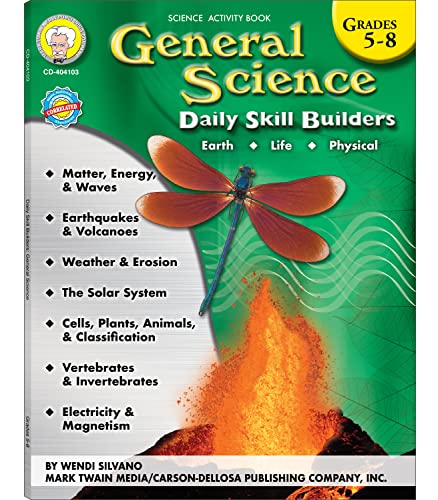
The product is designed to support the NSE standards and is an excellent resource that provides additional practice for students who are studying physical, earth, space, and life science curriculums in 5th to 8th grade. With this product, students can reinforce the knowledge and skills they have learned in the classroom and get better grades in their science classes.
The product is quite comprehensive, containing 96 pages of exercises and activities that cover a wide range of topics. It provides an excellent opportunity for students to apply what they have learned and to develop their critical thinking skills. The exercises are well-structured and easy to follow, making it easy for students to complete them on their own or with minimal assistance from their teachers or parents.
The product is an excellent investment for parents who want to support their children's education and for teachers who want to provide their students with additional resources to help them succeed in their science classes. It is a practical and effective tool that can make a significant difference in students' academic performance.
- Supports NSE standards
- Provides extra practice for students in physical, earth, space, and life science curriculums
- Comprehensive with 96 pages of exercises and activities
- Opportunity for students to apply what they have learned and to develop critical thinking skills
- Well-structured and easy to follow exercises
6. Nasa Adventure Kit: Lost In Space Challenge
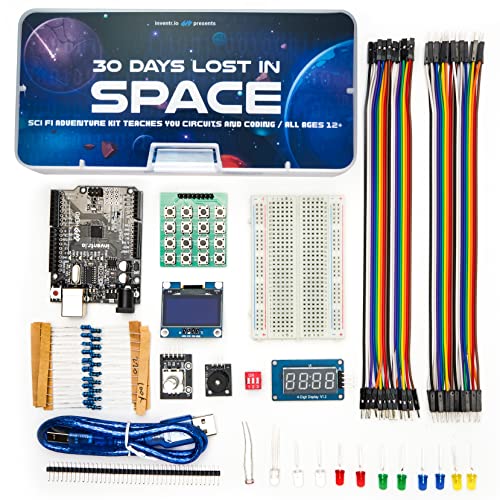
Embark on an exciting educational journey with the Adventure Kit by inventr.io, 30 Days Lost In Space. This thrilling story immerses adventurers in the world of circuits and coding in a fun and engaging way. Created by a renowned NASA researcher and college professor, this epic adventure takes you from crash landing on an alien planet to making detailed repairs and trying to get back home.
The Adventure Kit includes a set timeline that gets the adrenaline pumping as you become familiar with all the interesting parts in your handy sci-fi case. Adventurers gain confidence and skills while learning how to repair damaged control panels. Along the way, self-esteem soars higher as successful coding and circuitry fixes get made to the solar panel, air ballast system, security systems, and entertainment components. Kindly pros walk you through each step, making it totally enthralling.
This cutting-edge challenge presents industry-standard topics with community for accountability and consistent online updates for optimal learning. Having these incredible tech skill sets with hands-on experience often ignites a passion in young people, preparing them for future success. Who knows what this could lead to…a booming career in coding, programming, circuit design, or engineering?
The Adventure Kit is an exceptionally welcome choice for classroom or group projects, with reusable parts that make it easy to use. It also makes a thrilling gift for any young person (12+ suggested) interested in challenges, gadgets, coding, computers, wiring, math, and more. Gather a crew or work individually for 30 days, repairing the crashed shuttle’s complex systems, then getting it un-stuck and blasted off again headed for Earth.
The inventr.io team is delighted with the response and growing fan club. From middle school students to high schoolers and older, all over the world, the Adventure Kit: 30 Days Lost In Space set is unleashing open source and coding knowledge on bright and curious brains. The magic of it all centers on appealing storytelling and approachable professional guidance. It is a fantastic kit for beginners through advanced robotics and circuitry fans.
- Engaging and thrilling educational journey
- Fun and approachable way to learn circuits and coding
- Reusable parts make it ideal for classroom or group projects
- Great gift for young people interested in challenges, gadgets, coding, computers, wiring, math, and more
- Industry-standard topics with community for accountability and consistent online updates for optimal learning
Best Science Fair Projects For 8Th Grade FAQs
How can 8th grade students choose a science fair project that is both challenging and achievable?
Choosing a science fair project that is both challenging and achievable can be a daunting task for some 8th grade students. However, with proper guidance and some creativity, students can find a project that is both interesting and attainable. The first step is to identify a topic that interests them. This can be anything from physics, chemistry, biology, or environmental science. Once a topic is selected, students should research current trends and advances in that field. They can also speak to their science teacher or mentor for ideas and advice.
Next, students should consider the resources available to them, such as equipment, materials, and time. They should choose a project that they can realistically complete within the given time frame and with the resources available. It is also important to consider the level of difficulty of the project. Students should aim for a project that challenges them, but is not so difficult that it becomes frustrating or impossible to complete.
Lastly, students should remember to have fun and be creative. Science fair projects can be an exciting opportunity to explore and learn about a topic that interests them. By following these steps, 8th grade students can choose a science fair project that is both challenging and achievable.
How can 8th grade students ensure that their science fair projects are both scientifically rigorous and engaging to the audience?
There are several ways in which 8th grade students can ensure that their science fair projects are both scientifically rigorous and engaging to the audience. Firstly, students should choose a topic that interests them and has the potential to engage their audience. They should then conduct thorough research on their topic, using reliable sources to ensure that their project is scientifically rigorous. They should also consider using visual aids, such as graphs and diagrams, to make their project more engaging and easier to understand for their audience.
In addition, students should make sure that their project follows the scientific method, including identifying a problem or question, conducting research, developing a hypothesis, designing and conducting experiments, analyzing data, and drawing conclusions. They should also ensure that their project is well-organized and clearly presented, with a detailed explanation of their methods and results.
Finally, students should practice their presentation skills and be prepared to answer questions from their audience. They should be confident and enthusiastic about their project, and be able to explain their findings in a clear and concise manner. By following these tips, 8th grade students can create science fair projects that are both scientifically rigorous and engaging for their audience.
What are some interesting science fair project ideas for 8th grade students?
There are numerous interesting science fair project ideas for 8th grade students that can help them explore various scientific concepts and principles. Some of the most popular ideas include investigating the effects of different types of music on plant growth, exploring the physics behind roller coasters, examining the impact of pH levels on the growth of crystals, and testing the effectiveness of different types of natural pesticides.
Other exciting project ideas for 8th graders include studying the relationship between temperature and the rate of chemical reactions, analyzing the effects of different types of light on the behavior of animals, and exploring the physics of sound waves.
Students can also experiment with robotics and coding by building and programming their own robots or exploring the principles behind programming languages. Exploring environmental issues such as climate change and pollution can also be fascinating project ideas for 8th graders.
Overall, the key to a successful science fair project is to choose a topic that interests the student and allows them to explore new concepts in a fun and engaging way.
What are some tips for 8th grade students on how to effectively present their science fair projects to judges and audiences?
One of the most effective tips for 8th grade students to present their science fair projects to judges and audiences is to practice their presentation beforehand. This means rehearsing their speech, making notes on cue cards, and practicing in front of a mirror or someone else. It is important to make sure that the presentation is within the allotted time and that it covers all the essential points. Additionally, students should make sure that their presentation is engaging and visually appealing. This can be achieved through the use of props, charts, and graphs, as well as using storytelling techniques to make the presentation more interesting. Finally, it is important to be confident and enthusiastic about the project. This will help to capture the attention of the judges and audience and demonstrate the student's passion for science. By following these tips, 8th grade students can effectively present their science fair projects to judges and audiences with confidence and success.
What are the criteria that judges typically use to evaluate science fair projects for 8th grade students?
When judges evaluate science fair projects for 8th grade students, they typically use a set of criteria to assess the quality and effectiveness of the projects. These criteria usually include the scientific method, creativity, originality, and presentation skills.
First and foremost, judges expect students to follow the scientific method in their project. This means that the experiment must be structured, measurable, and repeatable, with clear hypotheses, data collection, analysis, and conclusions.
Secondly, judges look for creativity and originality. They want to see that students have chosen a unique and interesting topic, and that they have come up with innovative ways to test their hypotheses.
Thirdly, judges assess the overall presentation of the project. This includes the visual aids, the clarity of the written report, and the ability of the student to explain their research to the judges.
Finally, judges also consider the level of difficulty of the project, as well as the amount of time and effort the student has put into it.
In summary, judges evaluate science fair projects for 8th grade students based on their adherence to the scientific method, creativity and originality, presentation skills, and level of difficulty.


